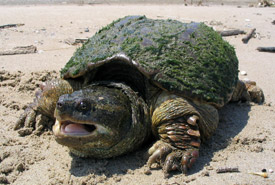Conservation Volunteers helping protect snapping turtle habitat in Nova Scotia

Snapping turtle (Photo by Ryan M. Bolton)
Imagine if you can a wide gravel beach overlooking a small, tranquil lake surrounded by rich forests. As the sun rises on the horizon, a turtle breaks the surface to survey the surrounding landscape. This snapping turtle has recently come out of hibernation and will soon lay its eggs on a beach in southwest Nova Scotia on the Nature Conservancy of Canada’s (NCC) Silver River property.
The Silver River property includes stands of both intact and regenerating Acadian forest and encompasses all or portions of three lake shorelines and sections of the Silver and Caribou Rivers, all of which form the headwaters of the Tusket River system. Turtle Beach is located here and is an important nesting site for snapping turtles.
Snapping turtles are our biggest freshwater turtle, with a shell measuring between 22-35 centimetres in length and weighing between 10-20 pounds. These turtles are shy creatures and will usually swim away from humans, but are very slow on land. If approached on land the turtle’s natural defense is to lunge and bite, since it can’t pull itself into its shell or run and hide. Take care around this turtle because its long neck can reach halfway back to its tail and it has a sharp beak that can leave a nasty bite!
Snapping turtles aren’t often found on land. They hibernate underwater in the winter, feed in the shallows or along the lake bottoms and usually only come out onto land to lay eggs.
Though they can be dangerous, these turtles are listed as vulnerable in Nova Scotia. Adults of this species have few natural predators, but are vulnerable to pollution, shoreline development, illegal harvesting and vehicle mortality. Snapping turtle nests can be destroyed by human activities and natural predators like raccoons. Their long life span (they can reach over 100 years old!), late maturity (12-20 years) and low nesting success mean these turtles need our help to sustain a healthy population.
Silver River is a remote property and does not have a lot of recreational usage. The upper portion of the beach, however, is open to ATVs, and is often used as a popular camping spot.
NCC will be at Turtle Beach May 21 with a number of volunteers to clean up the beach, rope off sensitive areas and install signage to educate the public on the importance of snapping turtles and the biodiversity of this amazing area.
Through this combination of education and mitigating access we hope to ensure a safer refuge for the turtle nests and contribute to the conservation of this species.


